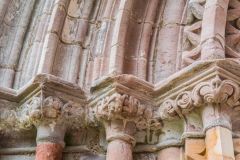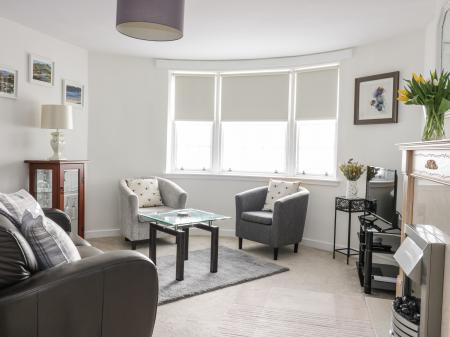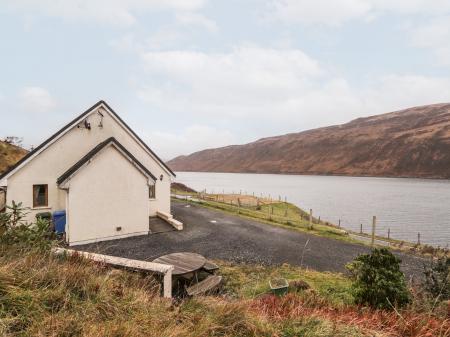
History
Dryburgh Abbey was founded in 1150 by Hugh de Morville for Premonstratensian canons from Alnwick Priory in Northumberland. De Morville was the Constable of Scotland and Lord of Lauderdale, but despite his Scottish titles he was a Norman lord, with his roots in England, so it is not too surprising that he invited English canons to populate his new abbey.
Construction of the new abbey concentrated on the abbey church, but even so, the church was not finished until the early 13th century.
Dryburgh became the mother house of the Premonstratensian order in Scotland, establishing daughter houses at Whithorn, in Dumfries-shire, and Fearn, in Ross-shire, among other locations. Dryburgh was never as prestigious or as wealthy as the three major Borders abbeys at Melrose, Kelso, and Jedburgh, but it lasted for 400 years in this peaceful spot by the Tweed.

The peaceful life of the canons at Dryburgh was disturbed in 1320 when a canon named Brother Marcus punched the abbot. For this serious offence he was expelled from the abbey. Much worse was to come just 2 years later in 1322 when the armies of Edward II, retreating from a reverse against the Scots, heard the abbey's bells ringing in the distance. According to legend, the army turned aside from the route of its march and sacked the abbey, setting fire to the monastic buildings and carrying off whatever loot they could grab.
The Scottish Reformation had a more long-lasting effect, however, and the numbers of monks dwindled until there were only 2 remaining in 1584. Eventually the last of the monks died or left, and the abbey was left to crumble into ruin.
Then the 11th Earl of Buchan stepped in. The Earl was a keen antiquarian, responsible for founding the Society of Antiquaries in Scotland in 1780. Buchan bought the Dryburgh site and turned it into a peaceful landscape garden, where flowers bloomed amid ancient ruins. When the Earl died in 1829 he was buried in the sacristy. His close friend, the novelist Sir Walter Scott, died just 3 years later and was buried in the north aisle.
Visiting
What a wonderful location! Dryburgh's setting beside the River Tweed is a delight; it seems like such a peaceful enclave, a place to escape from the world. It is no wonder that Sir Walter Scott and his ancestors chose to be buried here. What is also remarkable at Dryburgh is just how much of the monastic site is relatively intact. This really helps give a good idea of how the abbey was laid out and how the monks who lived here worked and worshipped.
Dryburgh provides a wonderful glimpse into the medieval world. Perhaps the highlight is the elegant architecture of the abbey church transepts. Historic Scotland describes the transepts as 'some of the best Gothic church architecture in Scotland', and they're right. In the north transept, sheltered from the weather, stand the tombs of writer Sir Walter Scott and Field Marshall Earl Haig, while the Earl of Buchan lies in the nearby sacristy.
Field Marshall Haig's gravestone is in the same style as those used in the large war grave cemeteries established after WWI. The Field Marshall's Haig ancestors came to the Scottish Borders with Hugh de Morville in the 12th century.

Sir Walter Scott was one of the most popular and influential writers of the 19th century. He was also an important figure in political life and helped foster an interest in Scottish culture and history both abroad and within his native Scotland. Scott was descended from the Haliburton family of Newmains, who once owned the Dryburgh site. The Haliburton family began to use the north transept as their burial ground, and Scott continued the tradition. One of the Haliburton owners of Dryburgh was John Haliburton (d. 1640), whose tomb can be found to the right of Scott's memorial. Also buried near Scott are his wife Charlotte, his son Walter, and his son-in-law John Lockhart.
The vaulted roof of the north transept is decorated with elaborately carved stone bosses, and scratched into the floor is a board for playing the popular medieval game of nine men's morris.
Another well-preserved part of the abbey is the 13th-century chapter house, where you can still see remnants of medieval painted wall plaster. The painted plaster is a very rare example of 13th-century art and most of it is preserved behind clear glass panels. In the chapter house floor are the carved outlines of two coffins, discovered during the Earl of Buchan's restoration work.
Nearby are the warming house and the east dormitory range. You can climb a set of broad stairs to a 16th-century residence for a member of the Erskine family, who acted as Commendators of Dryburgh during the last few decades of its existence.
The abbey grounds were planted with trees in the 18th century, turning the site into a leafy refuge where birds and wildflowers flourish. Near the eastern end of the abbey is the Dryburgh Abbey Yew, thought to have been planted in the 12th century, making it older than the abbey itself. The yew is including among the Forestry Commission Scotland's '100 Heritage Trees of Scotland'.
Our family loved visiting Dryburgh, and I can't wait to return.












